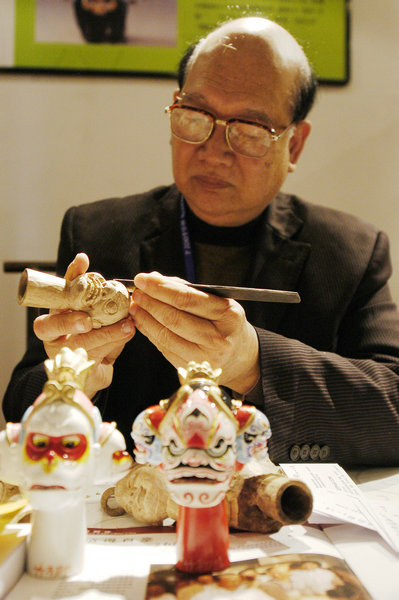 |
|
The figurines of Peking Opera and a Buddhist image by puppetry master Xu Zhuchu are among exhibits of an ongoing display at the National Art Museum of China.[Photo/China Daily] |
The puppets born under Xu's carving knives seem to "show" emotions of people and their spiritual pursuits. He finds inspiration from real-life experiences, but he also frequents storytelling performances, and observes Buddha statues inside temples, and he enjoys the Peking Opera and the Yueju Opera of Zhejiang province.
He sculpts the same smooth lines and graceful expressions as that of Buddhist images. He paints on the puppets with a palette as rich and bold as that of the facial make-up in traditional operas and nianhua (New Year paintings).
Above all, he injects infinite imagination and romantic feelings into them. He creates various features to reveal a greedy character: a pair of slanted eyebrows, buck teeth, dilated eyeballs and a bushy mustache, to name a few.
Among the hundreds of puppets he creates, one can hardly find two looking alike.
When Xu started making puppets, there were about 200 characters mostly derived from traditional opera scenarios. He has expanded the group to the current 500 to 600 characters from operas, folk and fairy tales and literary classics.
"The special aspect of Xu's puppets is that their eyes, eyebrows, mouths and lips can move-he has breathed life into them," says Wu Weishan, director of the National Art Museum of China.
"When he holds a puppet, he talks to it. When he presents the puppet to the audience, it can talk to the people."
Under his discipline, Xu's son and several young apprentices are carrying forward the handicraft. But Xu knows that few young people can "endure the loneliness of becoming a master" and these days it is the market recognition that makes them stay with puppetry.
He says puppet artists in the past barely supported themselves because they could find only two customers-puppet troupes and children.
"The troupes would use a set of puppets for dozens of years, while parents bought their children puppets mostly during festivals."
Now the times have changed, he says.
"We mass produce tourist souvenirs that are cheaply priced and we also make high-end artistic works. That's how I can pass down the art of puppetry to future generations."
Contact the writer at linqi@chinadaily.com.cn
If you go
9 am-5 pm, through Feb 28 (Mondays closed). National Art Museum of China, 1 Wusi Dajie, Dongcheng district, Beijing. 010-6400-1476.